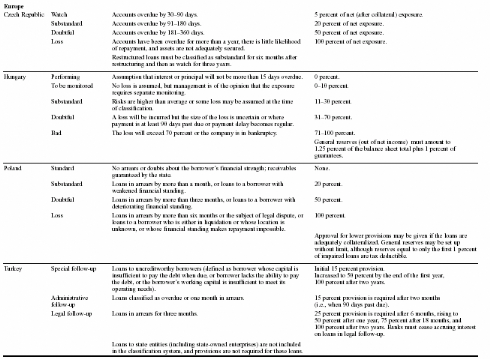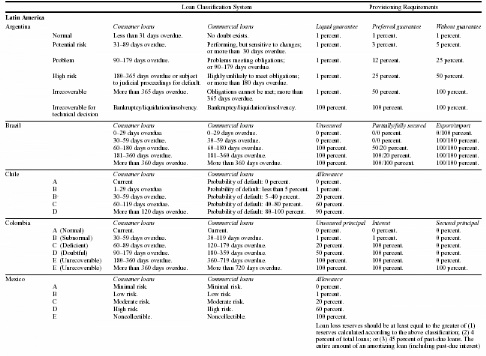II. Lessons from world banks crises
The issue of problem loans has arisen as one of the
most important sources of the «lost-
decade» in Japan (Fukuda and Koibuchi, 2005). Whereas
more than 60% of total assets of banks are loans to customers, the
safety of those loans becomes very critical and relevant for
the banking system stability. Many authors commented on
the issue of problem loans by considering the measures taken by the
Japanese government to overcome the problem. They also look at the experiences
of other countries.
In his paper on the Japanese banking crisis, Ueda (1998) affirmed
that the definition of bad
loans has changed over time and has been a source of
confusion. Initially, banks were
15 MBA in Banking and Finance
reporting only Non-accrual Loans. Later, they added Past Due
Loans and then Restructured Loans to the list. He underlined inefficient or lax
bank management as a cause of bad loans problems but emphasized the role of the
real estate industry. He found that in 1990s banks with a high exposure to real
estate industry suffered more from bad loans problems.
Nishimura et al (2001), in their critical paper on the Koizumi
Cabinet policies regarding the disposal of Japanese financial institutions' bad
loans, raised the following issues:
- Risk management skills: in their view the existence of bad
loans is not a problem in itself as bad loans are inevitable when banks
provide firms with credit. The financial institutions must practice
adequate risk management.
- Dynamism: the risk management policies must be adjusted to
match the industry structure changes. To evaluate the financial risks they
assume through lending, financial institutions must also have accurate
information on real estate prices when these are used as collateral. According
to the IMF (1999), the slow speed of restructuring in Japan is in part due to
the extensive ownership links among banks, other financial intermediaries, and
corporations.
The role of Asset Management Companies (AMCs) in dealing with
problem loans has been commented on by other authors.
Klingebiel (1999) thinks banks should be better placed to
resolve Non-Performing Loans
(NPLs) than centralized AMCs as they have the loan files and some
institutional knowledge
of the borrower. She adds that leaving the NPLs in
the banks' balance sheets may also provide better incentives for banks
to maximize the recovery value of bad debt and avoid future losses by
improving loan approval and monitoring procedures.
Her cross country experience showed that the countries that
transferred high percentages of their total assets to AMCs, namely Ghana,
Mexico and Philippines (figure 2) are the ones that faced recurrent problems
and did not achieve their narrow objectives. Even the achievement
of their broader objectives was unclear (cases of Ghana
and Philippines) and sometimes a
failure (case of Mexico).
16 MBA in Banking and Finance

Figure 2: Assets transferred to AMCs
Source: Kinglebiel (1999)
Table 1: Evaluating the Country Cases

Source: Kinglebiel (1999)
17 MBA in Banking and Finance
The role and independence of AMCs has also been pointed out in
China. Bartel and Huang (2002) disagreed with China's dealing with State Owned
Banks' (SOB) bad loans problem. For them the establishment of AMCs to
deal with China's bad loans problem was a good foundation upon which a
strong reform of the banking system can be built. Nevertheless, they pointed
out the lack of independent bank governance, and also underlined that creating
AMCs could lead to a moral hazard problem of encouraging banks to new low
quality loans. In their view, identification of bad loans is not trivial
in any banking system. The necessary information to distinguish a
good loan from a bad one is imbedded at the branch level, oftentimes
with the responsible loan officer.
The identification problem is magnified in China because
the standard international loan classification system was adopted only
recently.
Berger and DeYoung (1997) studied problem loans and cost
efficiency in commercial banks. They tested four hypotheses regarding the
relationships among loan quality, cost efficiency, and bank capital. Their data
suggested that: a. problem loans precede reductions in measured cost
efficiency; b. that measured cost efficiency preceded reductions in problem
loans; and c. reductions in capital of undercapitalized banks precede
increases in problem loans. They concluded that cost efficiency might be an
important indicator of future problem.
Cavallo and Majnoni (2001) studied a sample of 1176 large
commercial banks, 372 of which were from non-G10 countries, over the period
1988-1999. They found «robust evidence» that
the relationship between loan loss provisioning and banks'
pre-provision income was positive
for G10 banks and negative for non-G10 banks. They
concluded that non-G10 countries provisioned too little in good times and
were forced to increase provisions in bad times. This view is seconded by
Jiménez and Saurina (2005), who suggest banks to provision in
good times for the additional risk added to the portfolio due to credit growth.
Actually, they found evidence of a positive relation between rapid credit
growth and future non-performing loans
of banks. According to them banks could use the reserves
cumulated in boom periods to cover loan losses in bad times.
Laeven and Majnoni (2002) noted that many banks tended to delay
provisioning for bad loans until too late, when cyclical downturns had already
set in. According to them bankers created
too little provision in good times and then were forced
to increase them in economic downturns. They also found a considerable
difference in patterns followed by banks around
the world.
18 MBA in Banking and Finance
Dahiya, Puri and Saunders (2003) analyzed the effects of loan
sales on both the borrower and
the lender. They found that 42% of the firms whose loans were
sold filed for bankruptcy
within 3 years of the announcement of a loan sale by their bank
lender. On the other hand, the sale of a loan by a bank carries no significant
information and had no impact on its stocks
value; although loan sales appear to be made by generally weaker
banks.
| 

